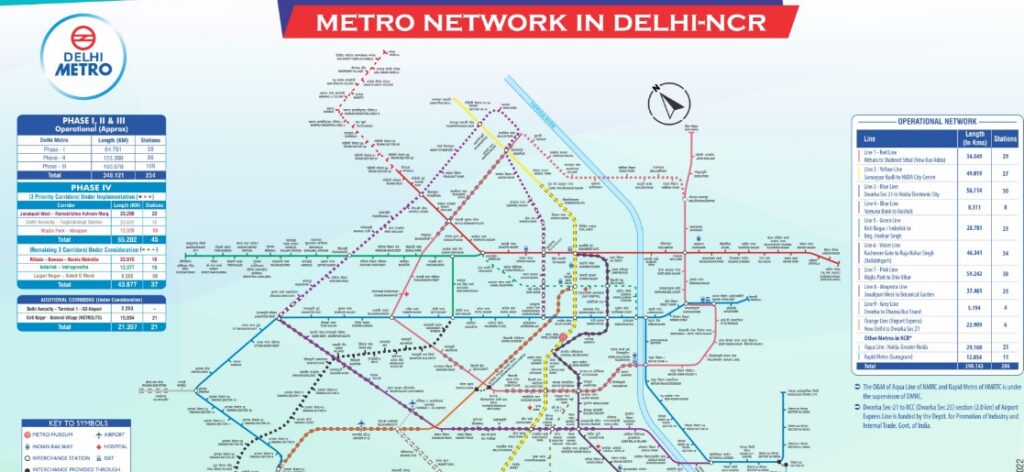
Delhi Metro Blue Line 2025: Station | Route | Maps | Timings
The Delhi Metro Blue Line 2025 stands as a vital corridor in the city’s transportation network, seamlessly connecting key regions across Delhi, Noida, and Ghaziabad. This guide delves into the intricate details of the Blue Line, offering insights into its stations, routes, maps, and operational timings.
Delhi Metro Blue Line 2025: An Overview
The Delhi Metro Blue Line, encompassing Line 3 and Line 4, serves as a backbone of the Delhi Metro Rail Corporation (DMRC) network. Spanning approximately 65 kilometers, it connects Dwarka Sector 21 to Noida Electronic City and extends from Yamuna Bank to Vaishali. This line traverses through bustling commercial hubs, residential areas, and significant landmarks, facilitating efficient commuting for millions daily.
Route and Station Details
Main Line: Dwarka Sector 21 to Noida Electronic City
The main line stretches from Dwarka Sector 21 in the west to Noida Electronic City in the east, covering a distance of about 56 kilometers. It encompasses 50 stations, including prominent ones like Rajiv Chowk, Karol Bagh, and Akshardham.
Branch Line: Yamuna Bank to Vaishali
The branch line extends from Yamuna Bank to Vaishali, covering approximately 8.5 kilometers with 8 stations. This segment enhances connectivity to Ghaziabad, catering to the commuting needs of the region.
Station List
Main Line Stations
- Dwarka Sector 21
- Dwarka Sector 8
- Dwarka Sector 9
- Dwarka Sector 10
- Dwarka Sector 11
- Dwarka Sector 12
- Dwarka Sector 13
- Dwarka Sector 14
- Dwarka
- Dwarka Mor
- Nawada
- Uttam Nagar West
- Uttam Nagar East
- Janakpuri West
- Janakpuri East
- Tilak Nagar
- Subhash Nagar
- Tagore Garden
- Rajouri Garden
- Ramesh Nagar
- Moti Nagar
- Kirti Nagar
- Shadipur
- Patel Nagar
- Rajendra Place
- Karol Bagh
- Jhandewalan
- Ramakrishna Ashram Marg
- Rajiv Chowk
- Barakhamba Road
- Mandi House
- Supreme Court
- Indraprastha
- Yamuna Bank
- Akshardham
- Mayur Vihar-I
- Mayur Vihar Extension
- New Ashok Nagar
- Noida Sector 15
- Noida Sector 16
- Noida Sector 18
- Botanical Garden
- Golf Course
- Noida City Centre
- Noida Sector 34
- Noida Sector 52
- Noida Sector 61
- Noida Sector 59
- Noida Sector 62
- Noida Electronic City
Branch Line Stations
- Yamuna Bank
- Laxmi Nagar
- Nirman Vihar
- Preet Vihar
- Karkarduma
- Anand Vihar
- Kaushambi
- Vaishali
Interchange Stations
The Blue Line offers seamless connectivity to various other metro lines through its interchange stations:
- Rajiv Chowk: Connects with the Yellow Line
- Mandi House: Intersects with the Violet Line
- Botanical Garden: Links to the Magenta Line
- Mayur Vihar-I: Connects with the Pink Line
- Kirti Nagar: Intersects with the Green Line
- Janakpuri West: Links to the Magenta Line
- Dwarka Sector 21: Connects with the Airport Express Line
- Anand Vihar: Intersects with the Pink Line
- Karkarduma: Links to the Pink Line
- Noida Sector 52: Connects with the Aqua Line
- Dwarka: Intersects with the Grey Line
Operational Timings
Weekdays (Monday to Saturday)
- First Train: 6:00 AM
- Last Train: 11:00 PM
- Peak Hours: Trains every 2–5 minutes
- Non-Peak Hours: Trains every 7–10 minutes
Sundays and Public Holidays
- First Train: 8:00 AM
- Last Train: 11:00 PM
- Frequency: Trains every 5–15 minutes
Facilities and Amenities
The Blue Line ensures a comfortable and safe journey for commuters by offering:
- Air-conditioned coaches
- Elevators and escalators for easy access
- Designated spaces for differently-abled individuals
- Real-time information displays
- CCTV surveillance for enhanced security
Future Developments
Plans aim to extend the Blue Line further into Ghaziabad, improving accessibility to areas like Indirapuram and Sahibabad. Authorities envision these expansions to accommodate increasing footfall and ease road traffic.
Eco-Friendly and Sustainable Transit
The Delhi Metro Blue Line 2025 promotes a green mode of transportation. The line reduces carbon emissions and helps combat pollution by encouraging people to switch from private vehicles to public transit. The metro system incorporates energy-efficient technologies and relies on renewable energy sources to power stations and trains.
Accessibility and Inclusivity Features
The Blue Line enhances accessibility for all users. Each station features ramps, elevators, and tactile paths for visually impaired individuals. Dedicated coaches ensure a safe environment for women, and multiple help desks provide on-site assistance to commuters who need it.
Smart Ticketing and Digital Integration
With the rise of digital infrastructure, the Delhi Metro Blue Line 2025 integrates smart card usage, QR code-based ticketing, and online recharges. Commuters enjoy seamless entry and exit with contactless gates and can plan their journey using DMRC mobile apps that provide real-time train schedules, fare details, and route suggestions.
Strategic Importance in Delhi-NCR Transit
The Blue Line plays a critical role in the Delhi-NCR transport network. It connects major business centers, educational institutions, and residential hubs. Thousands rely on this corridor for daily travel. This line eases traffic congestion on roads and fosters economic growth by improving regional connectivity.
Tips for First-Time Commuters
Travelers using the Delhi Metro Blue Line 2025 for the first time can follow simple tips for a better experience:
- Use the DMRC app to check timings and plan routes
- Arrive early during peak hours to avoid rush
- Keep your token or metro card handy
- Stand on the left side of escalators for others to pass
- Follow metro rules for a safe, comfortable journey
Conclusion
The Delhi Metro Blue Line 2025 continues to play a pivotal role in the city’s public transportation landscape, offering efficient and reliable services to millions. For more detailed information or specific inquiries, feel free to contact us.
Frequently Asked Questions
1. What is the starting and ending station of the Delhi Metro Blue Line?
The main line of the Blue Line runs from Dwarka Sector 21 to Noida Electronic City, while a branch line runs from Yamuna Bank to Vaishali.
2. How many stations are there on the Delhi Metro Blue Line?
The Blue Line includes a total of 58 stations — 50 on the main line and 8 on the branch line.
3. What time does the first train start on the Blue Line?
On weekdays, the first train departs at 6:00 AM. On Sundays and public holidays, it starts at 8:00 AM.
4. What are the peak hour timings for the Blue Line?
Peak hours typically occur between 8:00 AM to 11:00 AM and 5:00 PM to 8:00 PM, with trains running every 2–5 minutes.
5. Which Blue Line stations are interchange points with other lines?
Major interchange stations include Rajiv Chowk (Yellow Line), Mandi House (Violet Line), Kirti Nagar (Green Line), and Botanical Garden (Magenta Line), among others.
6. Does the Blue Line connect with Noida and Ghaziabad?
Yes, it connects Noida via Noida Electronic City and Ghaziabad via the Vaishali branch line.
7. Are there facilities for differently-abled passengers on the Blue Line?
Yes, all stations are equipped with ramps, lifts, tactile paths, and designated coach areas for differently-abled commuters.
8. Can I use QR code tickets on the Blue Line?
Yes, QR code-based tickets and smart cards are accepted across the entire Blue Line network.
9. How can I check the real-time status of Blue Line trains?
You can use the official DMRC mobile app for live train updates, schedules, and route planning.
10. Is the Blue Line being extended in the near future?
Yes, proposed extensions aim to improve connectivity to more areas in Ghaziabad, including Indirapuram and Sahibabad.


